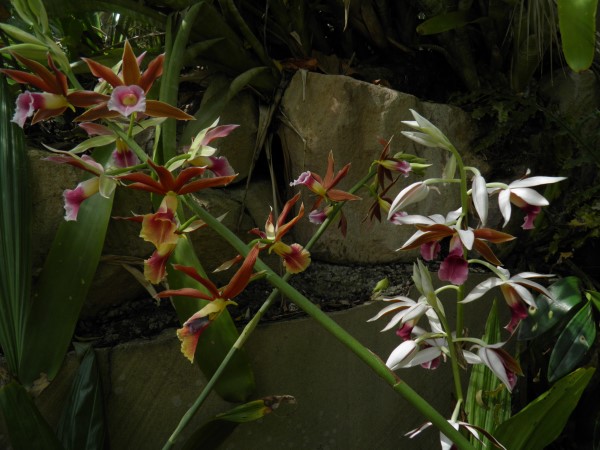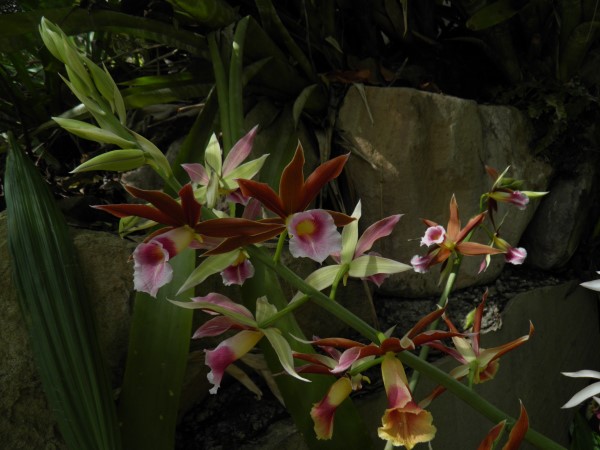


Return to Orchid Growing
PHAIUS
GROWING HINTS
GROWING HINTS

PHAIUS
Phaius species are the largest ground orchids in Australia and are commonly called swamp orchids. Phaius australis plants have a partially buried bulb-like structure at their base, about 7cm in diameter, which bears up to 7 leaves. Leaves are tapered at each end, and grow up to 1.25m long and 10cm wide. The leaves are dark green, thin-textured, pleated and spread in a tussock.
The flowering stem can reach 2m in height and bears 4-16 large and spectacular flowers. Flowers are 10-15cm in diameter, cinnamon-brown to brick-red on the inside, white on the outside and can have yellow veins. The colour of the central large petal ranges from yellow to bright purple. Pods are large, 3 chambered capsules, splitting when ripe to release numerous fine white seeds. (Barker 1995)
Habitat
Phaius australis grows in areas where soils are almost always damp, but not flooded for lengthy periods. Sands are generally the underlying soil type. P. australis are usually found in coastal habitats between swamps and forests or in suitable areas further inland. This includes swampy sclerophyll forest dominated by melaleucas, swampy forest that often have sclerophyll emergents, or fringing open forest and melaleuca swamp forest associated with rainforest species. P. australis has also been recorded in wallum, sedgeland, rainforest and closed forest. They often grow in deep shade, but can also occur in full sun. This species occurs at higher altitudes in northern Queensland. (Barker 1995)
Reproduction
The flowering season of Phaius australis is mainly between August and December. Flowers are long lasting and open progressively so that a plant is in flower for several weeks. Both cross and self pollination have been documented, but the exact breeding system is unknown. Seedlings have only been found in relatively open areas. (Barker 1995)
Large plants only become so if ample food is available, Phaius tankervilleae loves food while in growth. The addition of such things such as 'Blood and Bone', bone meal,chicken pellets etc., to the compost is welcome and additional feeding with such things as slow release fertilizers and dressings of organics will assist growth.
During Spring and Summer containers should be placed in a saucer of water, so that water level is 2 to 3 inches up the pot, which approximates the natural conditions for this species. It does not grow in water, but in soil and compost just above water level when it's habitat is flooded. An added bonus for the grower, is the species speedy multiplication by way of keikei's from spent racemes.
If the spike is removed as soon as flowers fall, cut into sections with at least one eye on each, and the sections planted into spagnum moss or some such, a high proportion of the eyes will develop into plantlets which may be potted on as they grow.
This species probably has the most spectacular and beautiful flower of any Australian native, and every grower should have a couple of plants.
The flowering stem can reach 2m in height and bears 4-16 large and spectacular flowers. Flowers are 10-15cm in diameter, cinnamon-brown to brick-red on the inside, white on the outside and can have yellow veins. The colour of the central large petal ranges from yellow to bright purple. Pods are large, 3 chambered capsules, splitting when ripe to release numerous fine white seeds. (Barker 1995)
Habitat
Phaius australis grows in areas where soils are almost always damp, but not flooded for lengthy periods. Sands are generally the underlying soil type. P. australis are usually found in coastal habitats between swamps and forests or in suitable areas further inland. This includes swampy sclerophyll forest dominated by melaleucas, swampy forest that often have sclerophyll emergents, or fringing open forest and melaleuca swamp forest associated with rainforest species. P. australis has also been recorded in wallum, sedgeland, rainforest and closed forest. They often grow in deep shade, but can also occur in full sun. This species occurs at higher altitudes in northern Queensland. (Barker 1995)
Reproduction
The flowering season of Phaius australis is mainly between August and December. Flowers are long lasting and open progressively so that a plant is in flower for several weeks. Both cross and self pollination have been documented, but the exact breeding system is unknown. Seedlings have only been found in relatively open areas. (Barker 1995)
Large plants only become so if ample food is available, Phaius tankervilleae loves food while in growth. The addition of such things such as 'Blood and Bone', bone meal,chicken pellets etc., to the compost is welcome and additional feeding with such things as slow release fertilizers and dressings of organics will assist growth.
During Spring and Summer containers should be placed in a saucer of water, so that water level is 2 to 3 inches up the pot, which approximates the natural conditions for this species. It does not grow in water, but in soil and compost just above water level when it's habitat is flooded. An added bonus for the grower, is the species speedy multiplication by way of keikei's from spent racemes.
If the spike is removed as soon as flowers fall, cut into sections with at least one eye on each, and the sections planted into spagnum moss or some such, a high proportion of the eyes will develop into plantlets which may be potted on as they grow.
This species probably has the most spectacular and beautiful flower of any Australian native, and every grower should have a couple of plants.
Let nature be your guide























